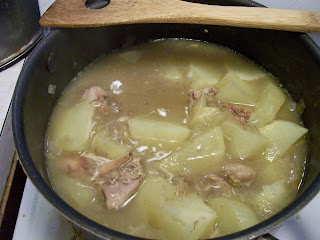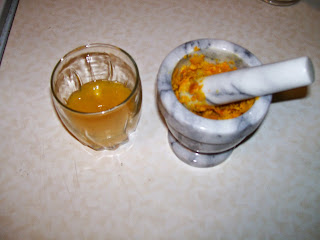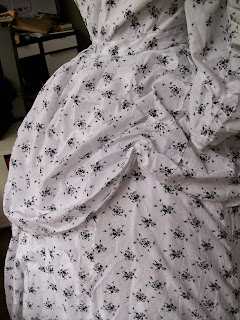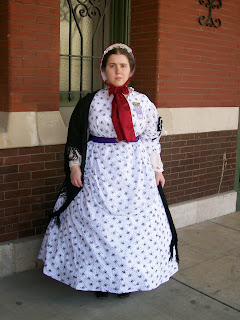Trip picture time! This was my first time travelling for an event, and my mom's first event ever. While there were some frustrating logistic issues, the other reenactors were delightful; the coordinators for the Ursuline Hill (progressive civilian) section were particularly praiseworthy. Springfield was very nice, too. I'm now horribly jealous of the Edwards House (has provenance for a ton of its furniture, and got to reproduce its actual wallpaper in the restoration), am ready to move into Lincoln's neighborhood.
Springfield was a ridiculously lovely
little town to visit. The residents
were uniformly polite and welcoming, even when beset on all sides by
strangely attired visitors. And they really dove into things: not only were the historic
houses draped in crepe, but even modern business in downtown, and
private houses along the procession got involved.
Sites definitely worth visiting:
The Abraham Lincoln Presidential Library and Museum. The museum is much more tourist-friendly of the
two, and has some very impressive technology going into its
theatrical presentations. The most amusing exhibit, in my opinion,
was the modern network news treatment of the 1860 Presidential
Election—and definitely read the crawl script.
The Lincoln House is gorgeous. Some of
the furnishings are original; the front rooms are decorated to match
the engravings made of them for
Frank Leslie's
in 1860 (a reprint of which, incidentally, is available in the gift
shop).
 |
| Lincoln House, draped in mourning, April 2015 |
The
neighborhood around the house, for one block in each direction, has
been restored to its c. 1860 appearance. Two of the houses
are open to visitors, with displays on the rehabilitation project.
The surviving buildings all have modern interiors, and restored
historic facades (excepting one house which is still in progress)
with explanatory placards noting the 1860s residents and their
relationship to the Lincolns.
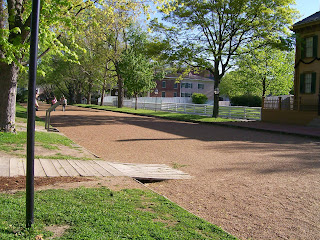 |
| 8th Street, looking north |
 |
| 8th Street, south of Jackson |
The
Old State Capitol was also quite
lovely; it has a rebuilt interior c. 1860 (originally in use 1839-1876),
and guides to walk you through it.
 |
| The Old Statehouse in Springfield |
 |
| Second floor stairs |
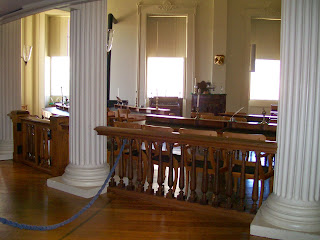 |
| The Representatives' Chamber |
Right across the street, stands one of
Abraham Lincoln's legal premises (unfortunately not open at present).
 |
| There's a neat statue of Abe, Mary, and the younger boys just outside |
Edwards Place, once of the home of Benjamin Stephenson Edwards (Mary Todd Lincoln's sister Elizabeth was married to Ben's brother Ninian), houses the Springfield Art Association. The ground floor has been restored to its mid
nineteenth-century appearance, including reproduced wallpaper
(printed from surviving scraps), appropriate china and glassware
based on excavated shards, some original furniture, and supplemental
period-appropriate pieces from other Springfield homes. There's also
a modern gallery attached.
 |
| Reconstructed pitcher (from shards found in privy) |
 |
| 1840's (?) sofa and loud carpet |
 |
| Original and reproduced wallpaper |
Oak Ridge Cemetery, of course, contains
the Lincoln family's very impressive tomb. The original entrance and
receiving vault were restored for the 150
th anniversary
exercises.
 |
| Restored historic entrance |
 |
| Lincoln Tomb |
 |
| Sculpture Details |
 |
| Restored Receiving Vault |
I've few pictures of the Funeral events
themselves, on account of my camera being distinctly
un-period-correct. There was a very well-attended symposium at U.
Illinois-Springfield Thursday evening. On Friday, Mom and I took Nanci Gasiel's class on making mourning badges.
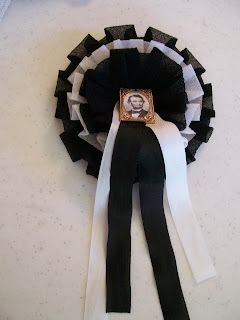 |
| Mourning badge, based on an original |
The class was held in the lovely Brinkerhoff mansion, on the grounds of Benedictine University. The University also which also housed some of the reenactment camping, as well as the civilian-centered sutlers, including Victorian Needle, P. Palmer, and the Dressmaker's Shop. On Saturday afternoon, the proprietresses (and certain other civilians) gave half-hour lectures on their particular topics of interest—we caught all or part of talks on jewelry, straw bonnet manufacture, misconceptions about underwear, laundry, and the different styles/shapes of men's hats.
 |
| Brinkerfhoff Mansion |
Saturday morning had the short
procession, in which the replica coffin was removed from its special
rail car, and transported to the Statehouse. The hearse was
accompanied by dignitaries in carriages, military columns, and a
crowd of citizens. As part of that crowd, I didn't get any
pictures.
For the longer procession (Statehouse
to Oak Ridge) on Sunday, however, I got some pictures from the
sidelines before joining the march.
 |
| Reproduced hearse, pulled by 6 horses |
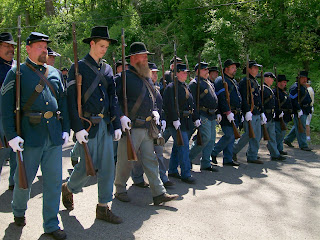 |
| Soldiers marching in the procession |
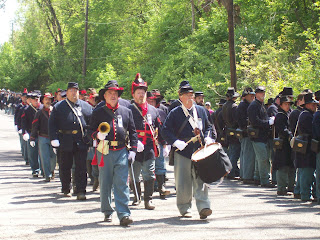 |
| Musicians in the procession |
 |
| Military units precede the hearse |


